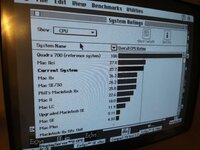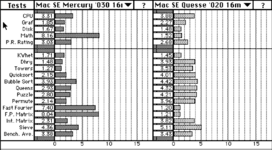This might be a somewhat relevant comparison. This is my Performer clone (On the left - 68030, 16mhz, w/ FPU, no SANE, 4mb ram on SE board) compared to my Total Systems Gemini (On the right - 68020, 16mhz, w/ FPU, no SANE, 4mb ram on accelerator). Ignore the benchmark names, I think I was really tired and typed "Mercury" instead of "Performer" thinking of another card, and my Quesse card is the same as the TS Gemini.
This isn't apples-to-apples since it's '020 vs '030, but you can see the '020 with ram on the accelerator is quite a bit faster at most of the individual math tests than the '030 using main board RAM. I am not sure why a couple of the math tests are so much faster with the '030, maybe there is something different about how the '020 and '030 handle those tests.
View attachment 67895


